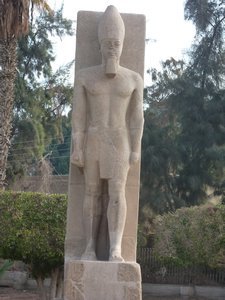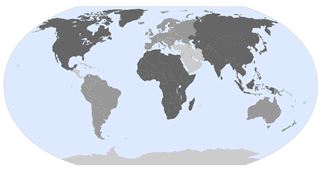Advertisement
Published: December 1st 2009

 Rameses II
Rameses II
Ruled Egypt for 60 odd years and was a very powerful manNice when things live up to your expectations. Films, documentaries and stories have fed my imagination since I was a pup and for me the Sahara became the quintessential desert, populated by Bedouins, small towns clustered around oases, mile after mile of sand hills, rocks eroded by the incessant winds - a hard, extremely fragile environment that takes no prisoners. Deserts are special places for me and this one lives up to its reputation as the daddy of them all.
We joined our Dragoman/Intrepid tour on the 23rd. This required us to move from our place at the Juliana Hotel where we were very comfortable - after we sorted a room issue. The place we moved to was OK but it was into a dorm room with 7 people, including us. Dorms I can live with but I would frankly prefer not to. A number of the others were also not too keen on the arrangement. They were not totally happy with the idea of sharing with the other gender.
Off to the Egyptian Museum on the first day. A guide who knew the spiel and had a sense of humour but couldn't do a lot more than that

 Saqqara
Saqqara
Crumbling a little but they are doing their best to maintain it without destroying the edificeand who was ready to deviate. The museum contains some material that is desperate for better interpretation and explanation. It is a real pity that such interesting and important artefacts are not properly presented. My niece should really take this place on and sort it out. It might take a couple of lifetimes but then her son/daughter could take over after her.
Before we actually left proper we took a trip - our first in the Dragoman truck (not bus, vehicle or whatever - it is a truck). Out to Memphis to visit the place where Ramses II statue lies in its own house. He was the man who negotiated the first written peace treaty - or so it is claimed. He either beat, or fought to a standstill, the Hittites with whom we became acquainted in Turkey in various places. The statue is definitely worth a look. The craftsmen and artisans of ancient Egypt were very, very skilled in the representation of bodies and faces in stone.
On then to the Saqqara and Giza Pyramids. At first glance when we arrived at Saqqara they seemed a little smaller than I had expected. A major building exercise is

 Top of a Pyramid
Top of a Pyramid
The steps you see in a typical pyramid are not really the way it was. They were smooth as the top of this one indicates.underway here to refurbish one of the major pyramids. There is a clear risk of the entire pyramid disintegrating as the foundations give way so they are going through a very difficult process of placing more stone in the foundations to try to hold the thing up. It is possible to be caught between the desire to see the 'original' and to see it as it was, rather than a mess of crumbling stone.
Giza is the real tourist icon. A number of large pyramids - haram in Arabic we were told - very impressive and with the squads of tourists, touts and sellers to prove it. The Sphinx may have been a little better if people - including the Australian army in WWI - hadn't used it for target practice.
Leaving Cairo was not a major issue for us. The pollution, incessant traffic noise, litter and rubbish outside the central area and major streets can become tiring after a while. Our route took us along the Nile for a little while but then pretty quickly out into the Sahara heading for Bahariya.
We arrived in Bahariya on the day before an important Muslim festival of Eid

 Lots of Rocks
Lots of Rocks
Some of these rocks were up to 15 tonnes. - the Eid for the end of the Haj. There was a lot of activity around the shops as people were getting their last minute buying done. We came here to camp and to have a look at some golden mummies and, with luck, some of the places from which they were excavated. The mummies were probably the best we had seen. Their clothing was well preserved and some had retained their golden death masks. To be honest, mummies don't do a great deal for me. I am impressed that they have survived that long and interested in the attitudes of people who had themselves mummified but, at the end of the day, they really just lay there pretty small and insignificant. I guess the desire for immortality has been around as long as people.
Pat couldn't join us on this visit to the mummies and the excavations. Her cooking team was in the markets buying up food for the breakfast, lunch and dinner that we were to have in the next day or so. There are 20 passengers on the truck with 2 leaders/drivers. The truck is a Mercedes with a V6 and carries 750 litres of diesel.

 The Sphinx
The Sphinx
Complete with bullet holes the Australians put in it when they used it for target practice in WW1It is well set up for camping and having a look about. Set up high with a lot of the storage underneath and with some special viewing seats that can be opend up to allow some people to sit in the open, effectively on top of the cab. The truck started its run in Helsinki, went to Beijing, came back to Istanbul and is now on its way to Capetown. Some of the people have been on for a year and others for extensive periods. There were 9 of us who joined in Cairo. People will leave and arrive at the various stages through Africa. We have scored a good group of people who we are getting to know. A Kiwi and a Pom are our leaders. They know their stuff and are doing a very good job of getting us organised and around.
After Bhariya we travelled through spectacular scenery to the White Desert. Now this qualifies a special place. We camped here among some surreal rock formations in total quiet. Not a suggestion of rubbish and no pollution. And it is simply beautiful. Just that little bit cool at night in the desert. We may have
made a slight error in our sleeping gear arrangements. This is a place that is worth a return visit.
From the White Desert through Farafra to Dhakla. Farafra is the smallest oasis in the Western Sahara. They have a small museum and a private art gallery. The artist is reputed to be world renowned. The work he does is good - to my eye at least. He has constructed a mud brick house on a number of levels. He sells some works but was saving his best for an exhibition in Paris in the next month. Unusually, he was handing some things out without charge, his prices were fixed and the qualtiy seemed to be pretty good. Something else to send home.
From the smallest oasis we travelled through a number of other oases to get to Dhakla which is said to be the biggest in the Western Sahara. I appreciate that everyone knows this but I need to make the point that between the oases there is basically a lot of sand and not much else. Add water, though, and watch the garden grow. The Dhakla oasis is 80 km long and about 25 km wide and
is a highly productive area.
Our camp at Dhakla was at a camping ground and hotel. We had the chance to upgrade to rooms for less than $A1.00. So we did. Wasn't the worst decision we have ever made but it was questionable whether the room or the tent was the more comfortable.
Complete with a police escort we moved the next morning to El Kharga. The town is clean and beautiful and, in this case at least, this is not false advertising. It was just a little off putting to come out of the museum - well presented material but not that much of it other than a mummified couple of rams - and have 6 fully equipped soldiers in bullet proof vests protecting our truck. But it seems that all that they were doing was looking after us, and making sure that we knew we were looked after. No dramas and no requests for baksheesh.
The primary business of each oasis seems to be agriculture. Some effort is clearly being made to expand production. We drove past a number of new 'blocks' where there were citrus, date palms and other tree and fruit crops being

 Unfinished Buildings
Unfinished Buildings
Egypt looks like a construction site. Apparently there is a tax advantage in never finishing a construction. Handy place to hang the washing too.cultivated. I guess that the water source is the oasis but in some cases there had been bores drilled. I suppose that the market for most of the produce is the population of that oasis and any nearby that can't grow enough for their needs. There is a substantial population in the desert at the oases. Dhakla has a population of 50,000 although most of the others would be smaller.
We have now come back to the Nile and have arrived in Luxor. The place used to be known by the Greeks as Thebes. We have visits planned to Karnak - the temple of Amun Ra - and the Valley of the Kings. There is a Museum and a another temple. Not sure about them. The museums generally have much the same things and it does become a little 'samey' unless you are really into the ancient history of the place.
From here it is up to Aswan for a few days and on the 7 Dec we cross Lake Nasser into Sudan.
Happy Birthday Sarah!!!
Advertisement
Tot: 0.137s; Tpl: 0.014s; cc: 13; qc: 27; dbt: 0.1005s; 1; m:domysql w:travelblog (10.17.0.13); sld: 1;
; mem: 1.2mb



























adamasao
non-member comment
looks great
Looks great! We'll have to have a look one day, I reckon.